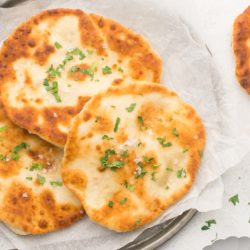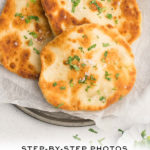Yoghurt Flatbreads

- Prep Time: 30 mins
- Cook Time: 30 mins
- Total Time: 1 hour
- Yield: Makes 12
- Category: Bread
- Method: Stove Top
- Cuisine: Indian
Easy Yoghurt Flatbreads which are thick, soft and chewy. Make this delicious, no-yeast flatbread recipe with step-by-step photos.
Ingredients
- 500 g plain flour (all-purpose flour)
- 1 tablespoon baking powder
- 1 tablespoon coarse sea salt (preferably Maldon sea salt)
- 500 g plain/natural yoghurt (full fat)
- vegetable oil for frying
Instructions
Make the dough
- Place flour, baking powder, salt and yoghurt into the large bowl of a food processor.
- Blitz until everything comes together into a soft dough.
- Lightly flour your work surface.
- Tip the dough onto your floured work surface.
Make the flatbreads
- Knead the dough lightly a few times until you have a soft ball which is no longer sticky. Add more flour as necessary.
- Roll the dough into a long log.
- Portion the dough into 12 pieces, or more if you prefer smaller flatbreads.
- Roll out one piece of dough into a round or oblong shape, about 5 mm thick. You might have to experiment with one or two pieces of dough to get your desired size and thickness.
Cook the flatbreads
- Heat a non-stick frying pan or non-stick crêpe pan with about 1 teaspoon of vegetable oil over medium-high heat.
- Place one rolled out piece of dough into the pan.
- While the flatbread is cooking on one side, use a pastry brush or silicon brush to brush the top of the flatbread (the uncooked side) with some oil.
- When the flatbread is nicely golden on the under-side, and lots of air bubbles have formed on the surface, flip it over. It should take about 2-3 minutes to cook the first side.
- Cook the remaining side until it is lightly golden. This should take about 1-2 minutes. It won’t be evenly coloured because of the air bubbles.
- Repeat with the remaining pieces of dough.
- Serve the flatbreads warm.
Kitchen Notes
 RECIPE CREDIT
RECIPE CREDIT
This recipe is inspired by Jamie Oliver’s Easy Flatbread recipe.
 REHEATING LEFTOVERS
REHEATING LEFTOVERS
Any leftover flatbreads can be kept in the fridge in a ziplock bag for several days. To reheat these flatbreads, you can microwave them until they are warmed through. I prefer to heat them on a non-stick pan for a few minutes each side.
 OVEN & STOVE TEMPERATURES
OVEN & STOVE TEMPERATURES
All recipes on this website have been tested on an induction stove and/or with a conventional oven (i.e. an oven without fan). All recipes on this website use temperatures for a conventional oven, unless otherwise mentioned. Convection ovens (i.e. fan-forced ovens) are typically 20°C/70°F hotter than conventional ovens, but please check your manufacturer’s handbook.
 CONVERSIONS
CONVERSIONS
To convert from cups to grams, and vice-versa, please see this handy Conversion Chart for Basic Ingredients.
View the recipe online: https://eatlittlebird.com/yoghurt-flatbreads/


